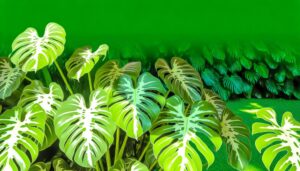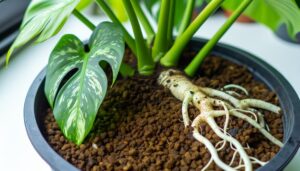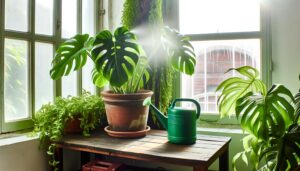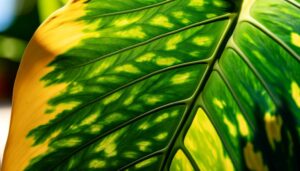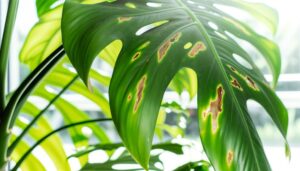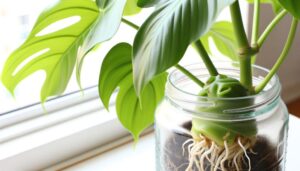Monstera Acacoyaguensis Vs Adansonii: Key Differences!
When comparing Monstera acacoyaguensis and Monstera adansonii, you’ll notice clear distinctions. Acacoyaguensis has larger leaves, up to 18 inches long, with prominent perforations and a climbing height of 15-20 feet.
Adansonii has smaller, oval leaves with distinct holes and reaches 10-12 feet. Both thrive in bright, indirect light and humid, 65°F to 85°F conditions.
Acacoyaguensis prefers slightly drier soil than Adansonii. For propagation, both use stem cuttings effectively.
You’ll find pest management involves similar tactics for both species. Interested in more detailed comparisons and care tips?
Comparison of Monstera Acacoyaguensis and Monstera Adansonii
| Feature | Monstera Acacoyaguensis | Monstera Adansonii |
|---|---|---|
| Scientific Name | Monstera acacoyaguensis | Monstera adansonii |
| Common Name | Acacoyaguensis Monstera | Swiss Cheese Plant, Adanson’s Monstera |
| Leaf Shape | Large, elongated with deep fenestrations | Heart-shaped with oval holes |
| Leaf Texture | Smooth | Smooth |
| Leaf Color | Dark green | Dark green |
| Fenestration | Deep splits and holes | Numerous oval holes |
| Growth Habit | Climbing vine | Climbing or trailing vine |
| Mature Size | Up to 10-15 feet indoors | Up to 10-13 feet indoors |
| Light Needs | Bright, indirect light | Bright, indirect light |
| Watering | Keep soil moist but not waterlogged | Keep soil moist but not waterlogged |
| Temperature | Prefers 65-85°F (18-29°C) | Prefers 65-85°F (18-29°C) |
| Humidity | High humidity (above 60%) | High humidity (above 60%) |
| Soil Type | Well-draining, rich potting mix | Well-draining, rich potting mix |
| Propagation | Stem cuttings | Stem cuttings |
| Toxicity | Toxic to pets and humans | Toxic to pets and humans |
| Special Care | Regular misting and occasional fertilizing | Regular misting and occasional fertilizing |
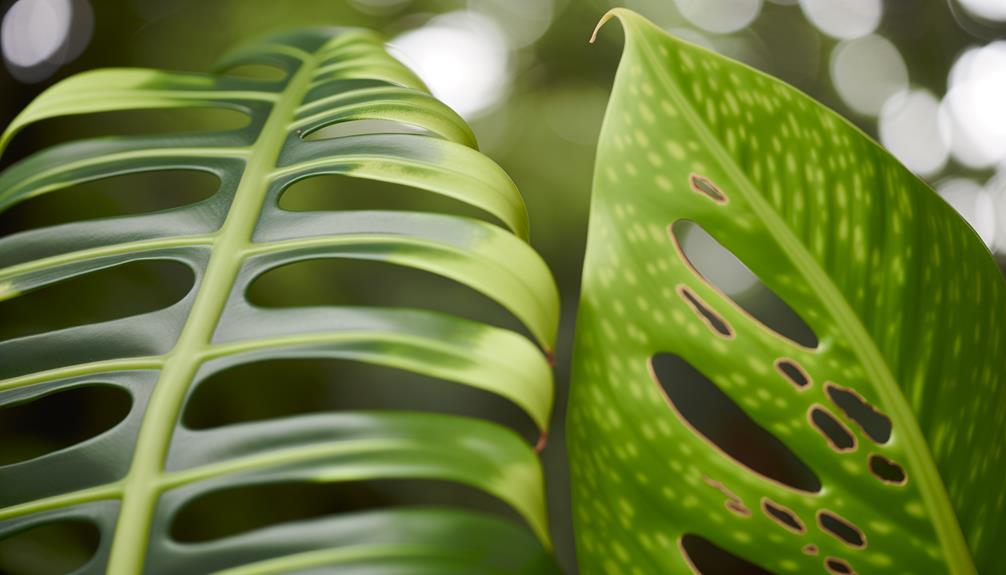
Origins and Natural Habitat
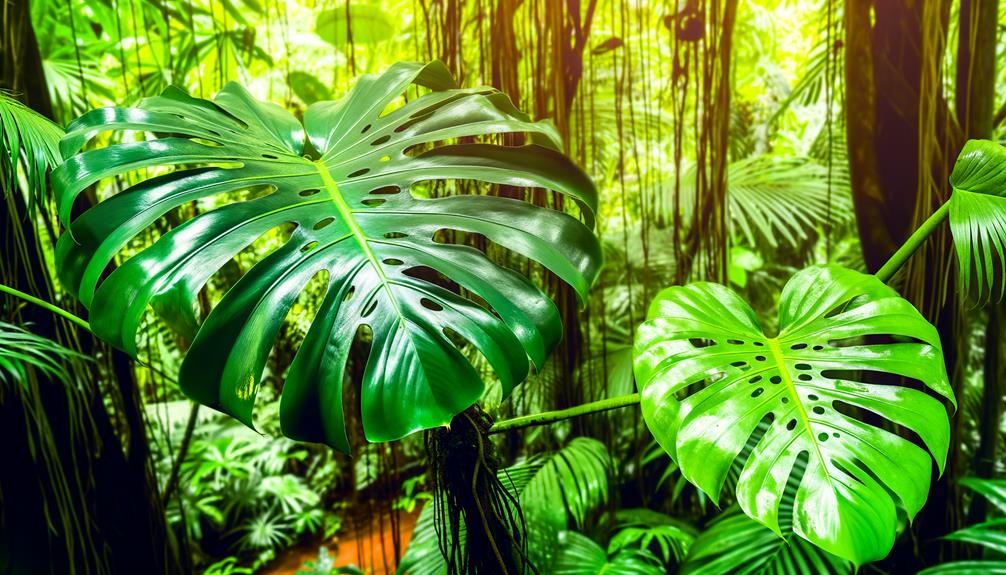
Monstera acacoyaguensis, originating from the tropical rainforests of Mexico, thrives in humid, shaded environments with consistent temperatures ranging from 65°F to 85°F. You’ll find these plants nestled beneath the dense canopy, where indirect light is abundant.
They prefer soil that’s rich in organic matter, offering excellent drainage and aeration.
Maintaining a relative humidity of 60% to 80% is essential for their best growth. In their natural habitat, they benefit from frequent rains and the consistent moisture of the rainforest floor.
The ecosystem provides a steady nutrient supply through decaying plant material. Understanding these conditions helps you replicate their natural habitat, ensuring your Monstera acacoyaguensis remains healthy and vibrant indoors.
Leaf Shape and Size
The leaves of the Monstera acacoyaguensis exhibit a distinct fenestrated pattern, reaching up to 18 inches in length and 12 inches in width, with deep incisions that contribute to their characteristic appearance.
You’ll notice the prominent perforations primarily near the midrib, creating an intricate, lace-like structure.
In comparison, Monstera adansonii features smaller leaves, generally measuring 6 to 12 inches in length and 5 to 7 inches in width. These leaves have numerous oval to elliptical holes, giving them a Swiss cheese-like appearance.
Unlike the acacoyaguensis, the adansonii’s fenestrations are more evenly distributed and less deeply incised.
Both species display a vivid green hue, but their unique leaf patterns and sizes set them distinctly apart.
Growth Patterns
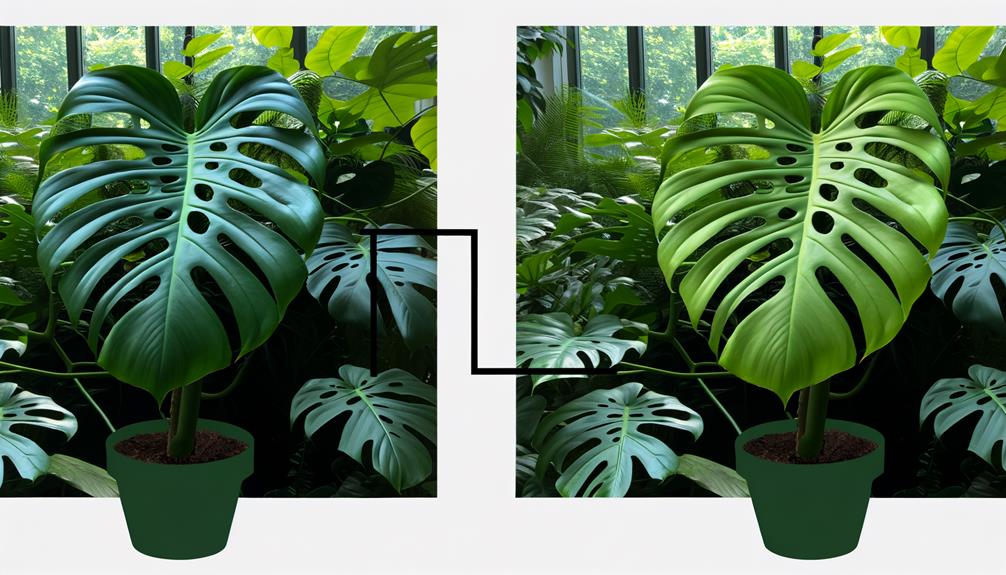
When it comes to growth patterns, you’ll observe that Monstera acacoyaguensis tends to climb vigorously, often reaching heights of up to 15-20 feet with proper support and ideal conditions. This plant exhibits robust vertical growth facilitated by its adventitious roots.
In contrast, Monstera adansonii, while also a climbing species, typically achieves a more modest height of 10-12 feet.
Key growth pattern differences include:
- Climbing Mechanism: Monstera acacoyaguensis uses larger aerial roots.
- Stem Thickness: Acacoyaguensis has thicker, more substantial stems.
- Leaf Size: Larger leaves on acacoyaguensis contribute to faster growth.
- Growth Speed: Acacoyaguensis grows more rapidly under favorable conditions.
- Support Needs: Both require sturdy support, but acacoyaguensis demands stronger structures.
Understanding these nuances aids in ideal cultivation.
Light Requirements
When considering light requirements for Monstera Acacoyaguensis and Adansonii, you should note their best sunlight conditions, which range between 10,000 to 20,000 lux.
Both species show excellent indoor light adaptability, thriving under bright, indirect light.
However, their shade tolerance levels differ slightly, with Adansonii displaying greater resilience in lower light environments.
Optimal Sunlight Conditions
Typically, Monstera acacoyaguensis and Monstera adansonii thrive best in bright, indirect sunlight, mimicking their natural understory habitat. You should aim to provide 10,000 to 20,000 lumens to ensure peak growth. Direct sunlight can cause leaf burn, while insufficient light leads to leggy growth.
- Light Intensity: 10,000-20,000 lumens
- Duration: 12-14 hours of light per day
- Light Source: East or west-facing windows work well
- Leaf Position: Rotate plants weekly for even light exposure
- Sunlight Filtering: Use sheer curtains to diffuse light
This optimal light environment encourages healthy growth, vibrant foliage, and can even promote the development of fenestrations in mature leaves. Maintaining consistent lighting conditions helps prevent stress and ensures your Monstera plants thrive in their indoor environment.
Indoor Light Adaptability
Monstera acacoyaguensis and Monstera adansonii display remarkable adaptability to various indoor light conditions, thriving under both natural and artificial light sources with careful management.
When positioning these plants, aim for indirect light with an intensity of 1000-2000 lux for peak growth. Direct sunlight can cause leaf scorching, while low light may slow growth rates.
Employing full-spectrum LED lights with a color temperature of 5000-6500K can mimic natural sunlight effectively. Rotate the plants periodically to guarantee even light exposure.
Avoid placing them directly under intense fluorescent lights, which can lead to photoinhibition. Regularly monitor light levels using a lux meter to maintain consistent conditions.
This detailed approach ensures your Monstera plants thrive indoors.
Shade Tolerance Levels
You’ll find that both Monstera acacoyaguensis and Monstera adansonii demonstrate exceptional shade tolerance, thriving with minimal light conditions as low as 200-500 lux. These species have evolved to flourish under the dense canopies of tropical rainforests, where they receive filtered sunlight.
- Light Intensity: Optimal growth observed between 200-500 lux.
- Photosynthetic Efficiency: Efficient at low light due to large leaf surface area.
- Growth Rate: Slower in low light but maintains health.
- Leaf Morphology: Adaptations include thinner leaves to maximize light capture.
- Chlorophyll Density: Higher chlorophyll concentration enhances light absorption.
For your Monstera, indirect light is ideal. Position them in areas receiving dappled sunlight or filtered through sheer curtains for best results.
Watering Needs
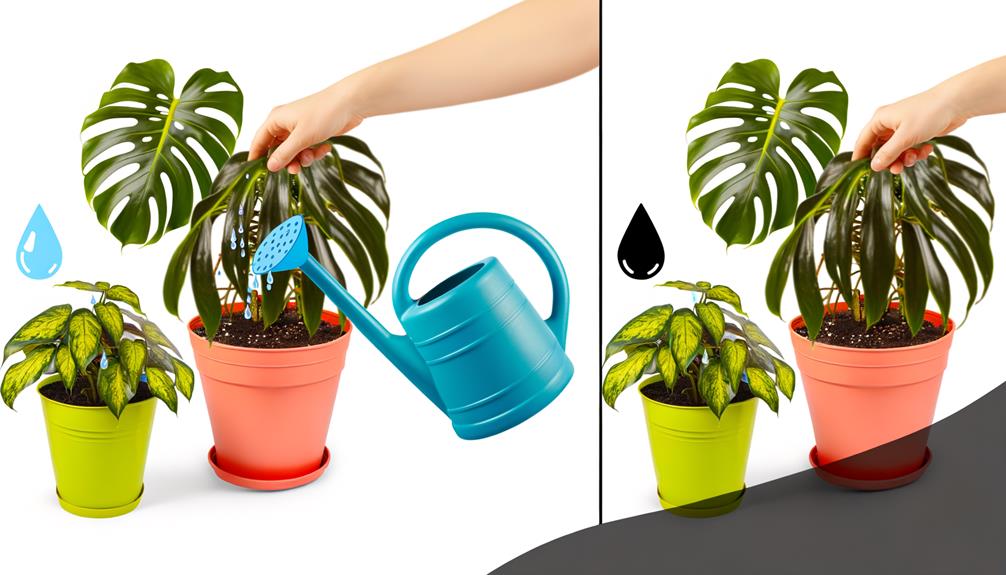
Securing ideal watering for both Monstera acacoyaguensis and Monstera adansonii requires an understanding of their respective moisture preferences and soil drainage needs.
You should water Monstera acacoyaguensis when the top 2-3 inches of soil feel dry, guaranteeing the water penetrates deeply to prevent root desiccation. Monstera adansonii prefers slightly higher moisture levels; water when the top 1-2 inches are dry.
Both species benefit from well-draining substrates to avoid waterlogging, which can cause root rot. Use a moisture meter for precise readings, aiming for a soil moisture level around 40-60%.
Avoid allowing water to sit in the saucer. Adhering to these guidelines secures optimal hydration, promoting healthy growth and preventing common watering-related issues.
Soil Preferences
When considering soil preferences for Monstera acacoyaguensis and Adansonii, prioritize excellent drainage and aeration.
Prioritize the soil mix includes components like perlite or orchid bark to maintain a balanced structure.
Both species thrive in a nutrient-rich substrate, so incorporate a blend of organic matter and slow-release fertilizers to support peak growth.
Drainage and Aeration Needs
For the most favorable growth, Monstera acacoyaguensis and Monstera adansonii require well-draining soil mixtures composed of equal parts peat moss, perlite, and orchid bark to ensure proper aeration and moisture retention.
Ensuring prime drainage prevents root rot, a common issue for these species. Adequate aeration is crucial for root health, promoting oxygen exchange and preventing fungal growth.
- Peat Moss: Retains moisture while providing airy texture.
- Perlite: Improves drainage and prevents soil compaction.
- Orchid Bark: Adds structure, enhancing aeration.
- pH Level: Maintain a slightly acidic pH of 5.5-6.5.
- Pot Selection: Use pots with abundant drainage holes.
Nutrient-Rich Soil Composition
In addition to proper drainage and aeration, Monstera acacoyaguensis and Monstera adansonii thrive in soil enriched with organic matter and balanced nutrients, securing robust growth and vibrant foliage.
You’ll want to use a well-draining potting mix, incorporating 40% peat moss, 30% perlite, and 30% compost or aged manure. This combination enhances moisture retention without waterlogging roots.
Also, adding a slow-release, balanced fertilizer with an N-P-K ratio of 20-20-20 can provide essential macronutrients over time. Regularly amending the soil with worm castings or decomposed leaf litter supports microbial activity, promoting nutrient availability.
Maintaining soil pH between 5.5 and 7.0 ensures prime nutrient uptake, crucial for these species’ healthy development.
Temperature and Humidity
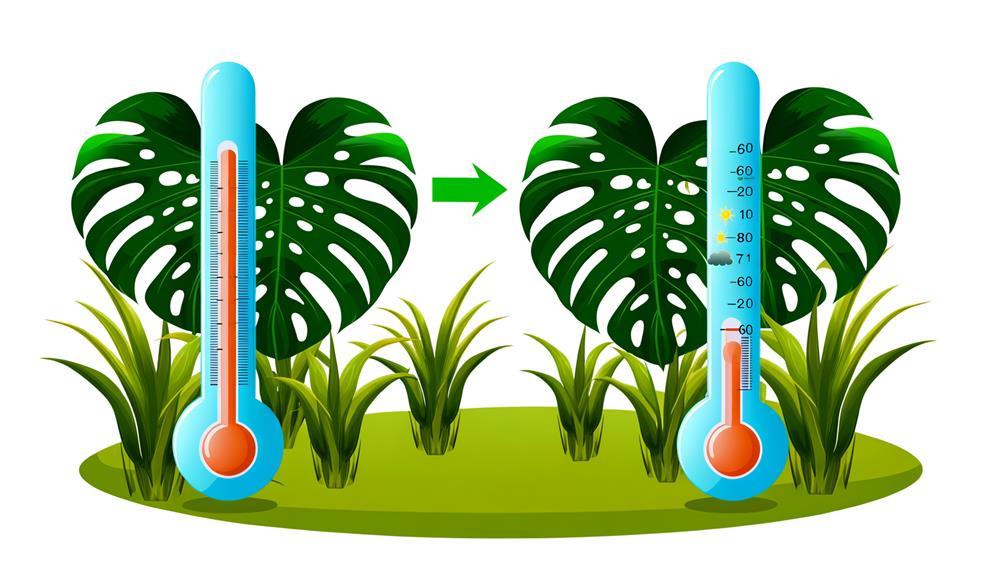
To maximize growth, Monstera Acacoyaguensis and Adansonii thrive best in temperatures ranging from 65°F to 85°F with humidity levels maintained between 60% and 80%. This range mimics their native tropical environments, guaranteeing ideal photosynthesis and cellular respiration.
- Temperature Tolerance: Both species can withstand brief periods outside this range but prolonged exposure may cause stress.
- Humidity Control: Utilize a hygrometer to monitor levels.
- Humidity Enhancements: Use a humidifier or place plants on a humidity tray.
- Airflow: Ensure adequate ventilation to prevent fungal growth.
- Temperature Consistency: Avoid placing plants near drafty windows or heating vents to maintain stable conditions.
Common Pests and Diseases
Monstera Acacoyaguensis and Adansonii are commonly affected by pests such as spider mites, aphids, and mealybugs, as well as diseases like root rot and powdery mildew.
Spider mites, measuring about 0.5 mm, cause stippling on leaves. Aphids, approximately 2 mm, cluster on new growth, distorting it. Mealybugs, around 3 mm, leave cotton-like residues on stems and leaves.
To address these infestations, use insecticidal soap or neem oil, applying every 7-10 days.
Root rot, caused by overwatering, leads to brown, mushy roots. Maintain well-drained soil and reduce watering frequency. Powdery mildew appears as a white, powdery coating on leaves; prompt removal of affected foliage and improved air circulation are essential. Regular monitoring helps sustain plant health.
Propagation Methods
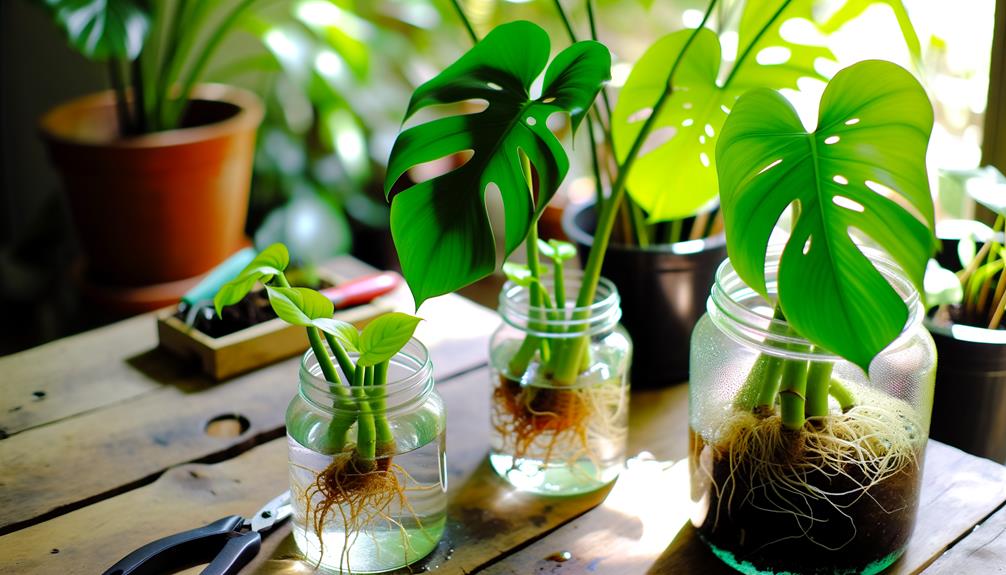
While managing pests and diseases safeguards your Monstera Acacoyaguensis and Adansonii remain healthy, mastering propagation methods can help you expand your collection with ease.
To propagate these species successfully, follow these detailed steps:
- Stem Cuttings: Use sterilized scissors to cut 4-6 inch segments with at least one node.
- Water Propagation: Submerge the cut end in water, making certain the node is underwater. Change the water every 3-5 days.
- Soil Propagation: Plant the cutting in a well-draining soil mix and maintain consistent moisture.
- Rooting Hormone: Dip the cut end in rooting hormone to enhance root development.
- Humidity: Maintain high humidity (60-80%) using a plastic bag or humidity dome.
These methods promote robust root systems and healthy growth.
Aesthetic Appeal
When comparing the aesthetic appeal of Monstera Acacoyaguensis and Adansonii, you’ll notice distinct differences in leaf shape and growth patterns.
The Acacoyaguensis features larger, more elongated leaves with deep, irregular fenestrations, while the Adansonii has smaller, oval leaves with uniform, perforated holes.
Additionally, the Acacoyaguensis tends to grow more upright, reaching heights of up to 2 meters, whereas the Adansonii exhibits a vining habit, often extending up to 3 meters.
Leaf Shape Differences
Characterized by their unique fenestrations and varying leaf sizes, the Acacoyaguensis and Adansonii offer distinct visual appeals that cater to different aesthetic preferences.
The Acacoyaguensis features larger, more elongated leaves with deep, symmetrical cuts. In contrast, the Adansonii boasts smaller, more oval-shaped leaves with numerous, irregular holes.
You might find these differences intriguing:
- Acacoyaguensis: Leaves can reach up to 60 cm in length, showcasing dramatic splits.
- Adansonii: Leaves typically measure around 20-30 cm, with a higher density of fenestrations.
- Acacoyaguensis: Exhibits a more uniform, symmetrical pattern.
- Adansonii: Presents a more random, perforated appearance.
- Acacoyaguensis: Ideal for a bold, structured aesthetic.
Growth Pattern Variations
Understanding the growth pattern variations between Monstera Acacoyaguensis and Adansonii highlights their distinct aesthetic appeals and can help you choose the right plant for your space.
Monstera Acacoyaguensis exhibits a more upright, columnar growth habit, reaching up to 2 meters in height. Its internodal spacing is tighter, roughly 5-7 centimeters apart, resulting in a denser appearance.
In contrast, Monstera Adansonii features a more trailing or climbing growth pattern, extending laterally and vertically. Its internodal spacing ranges from 10-15 centimeters, giving it a more open and airy look.
These differences affect the visual impact; Acacoyaguensis suits compact, vertical spaces, while Adansonii enhances areas needing a cascading or climbing effect. Choose based on your spatial and aesthetic requirements.
Conclusion
In the grand tapestry of botany, the Monstera acacoyaguensis and Monstera adansonii are two stunning threads that weave a tale of beauty and resilience.
With their distinct leaf shapes, growth patterns, and care requirements, each offers unique charms for your indoor jungle.
By understanding their nuances, you can cultivate these green gems to thrive like stars in a botanical galaxy.
So, immerse yourself, nurture them, and watch your verdant sanctuary flourish.

